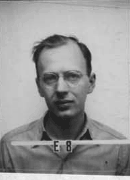Kenneth Greisen
Kenneth Ingvard Greisen (born January 24, 1918 in Perth Amboy , New Jersey , † March 17, 2007 in Ithaca , New York ) was an American physicist who dealt with nuclear physics and high-energy astrophysics.
Life
Greisen received his doctorate in physics from Cornell University in 1942 under Bruno Rossi ( Intensity of cosmic rays at low altitude and the origin of the soft component ). He was involved in the Manhattan Project from 1943 to 1946 in Los Alamos, where he was group leader. In 1945 he was an eyewitness to the Trinity test (as a member of the detonation team ). He then went back to Cornell University, first in 1946 as an assistant professor and later as a professor of physics. From 1975 he was professor of astronomy and from 1976 to 1979 head of the faculty of astronomy and from 1978 to 1983 dean of the faculty. In 1986 he retired. From 1975 to 1981 he was an adjunct professor at the University of Utah.
He dealt with experiments on cosmic rays and gamma-ray astronomy, initially working with balloons. In 1971 he and colleagues discovered gamma radiation synchronized with the pulsar in the Crab Nebula. He proposed the GZK cutoff in 1966 independently of Georgi Sazepin and Wadim Kuzmin in the Soviet Union at the same time.
In 1971 he was one of the founders and first chairman of the American Astronomical Society's High Energy Astrophysics Section . At Cornell University in 1969, he led a group that modernized the introductory physics courses.
Since 1974 he has been a Fellow of the National Academy of Sciences .
literature
- Obituary by David Cassel, Edith Cassel, Donald Holcomb, Physics Today, July 2007
Fonts
- with Bruno Rossi Cosmic ray theory , Reviews of Modern Physics, Volume 13, 1941, p. 240
- End of the cosmic ray spectrum? , Physical Review Letters, Volume 17, 1966, p. 748 (GZK cutoff)
Web links
Individual evidence
- ↑ Date of birth and career dates from American Men and Women of Science , Thomson Gale 2004
| personal data | |
|---|---|
| SURNAME | Greisen, Kenneth |
| ALTERNATIVE NAMES | Greisen, Kenneth Ingvard |
| BRIEF DESCRIPTION | American physicist |
| DATE OF BIRTH | January 24, 1918 |
| PLACE OF BIRTH | Perth Amboy , New Jersey |
| DATE OF DEATH | March 17, 2007 |
| Place of death | Ithaca , New York |
